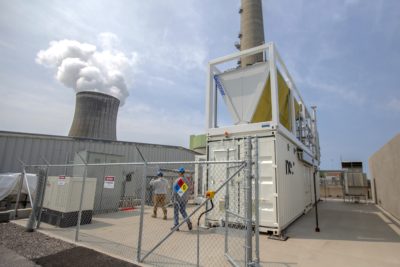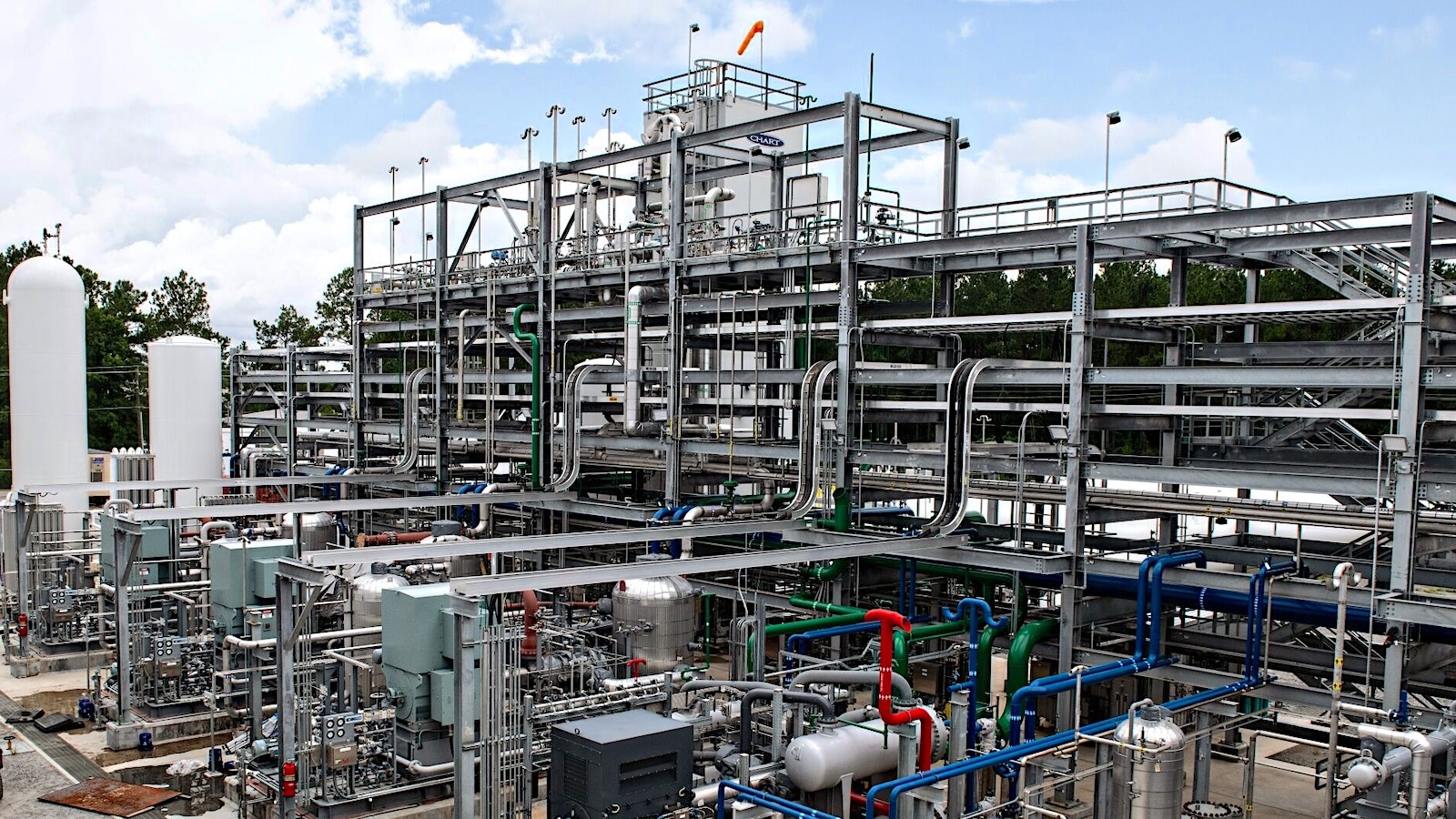As a part of a $7 billion funding in hydrogen, the U.S. Division of Power is dedicated to constructing a community of hydrogen amenities and pipelines centered in southeast Pennsylvania. Critics are questioning the venture’s expense and its web financial savings in carbon emissions.
Within the fall of 2023, the Biden administration introduced $7 billion in funding for seven hydrogen hubs, slated to be constructed throughout the nation over the subsequent eight to 12 years. If all goes as deliberate, a kind of hubs, the Mid-Atlantic Clear Hydrogen Hub (MACH2) — a community of greater than a dozen interconnected hydrogen manufacturing facilities, storage amenities, pipelines, and new photo voltaic farms that may energy these operations — will stretch from southeastern Pennsylvania and neighboring southern New Jersey into Delaware. Anticipated to obtain $750 million in federal funding, MACH2 is projected to create roughly 20,800 jobs within the Delaware Valley area, of which 6,400 can be everlasting.
The U.S. Division of Power (DOE) says {that a} sufficiently sturdy buildout of hydrogen manufacturing may energy steelmaking, cement manufacturing, and different energy-intensive heavy industries, which account for greater than a fifth of nationwide carbon emissions and have been notoriously onerous to decarbonize, in addition to fueling ships, airplanes, and vehicles. However some environmentalists and power consultants query whether or not investing a lot cash in hydrogen may siphon funding from more practical decarbonization methods. Even a so-called “inexperienced” hub, which runs completely on renewable power, they are saying, won’t present the promised carbon-reduction advantages and will doubtlessly even improve emissions.
And residents of potential host communities — significantly the hard-pressed metropolis of Chester, Pennsylvania, the place a few of the MACH2 amenities are deliberate — are involved that they may bear the brunt of the potential dangers and well being hazards that hydrogen manufacturing and transport may deliver.
Few particulars in regards to the Mid-Atlantic hydrogen hub have been shared with the general public, unnerving neighborhood teams.
Scientists found how one can extract usable hydrogen from water molecules utilizing electrolysis within the 1800s, and way back to 1874, novelist Jules Verne predicted it might sometime be “the coal of the long run.” Hydrogen is, in spite of everything, probably the most considerable factor on the planet, and it produces no carbon emissions when burned. The USA already produces 10 million metric tons of hydrogen a 12 months — however most of it’s derived from pure gasoline and is basically utilized in petroleum refining and in making ammonia for manufacturing fertilizer. Each ton of ammonia produced generates 2.6 tons of lifecycle greenhouse gasoline emissions, in response to a report printed in Inexperienced Chemistry.
Nonetheless, scaling up low- or zero-carbon hydrogen manufacturing wasn’t thought-about financially viable till passage of the Bipartisan Infrastructure Regulation in 2021 and the Inflation Discount Act in 2022, which supply substantial tax credit to producers of fresh hydrogen.
Right this moment, some proposed hubs are planning on producing “blue” hydrogen — that’s, hydrogen created utilizing pure gasoline however with the ensuing carbon emissions captured and saved underground. Representatives of the MACH2 hub say that 82 p.c of their manufacturing can be “inexperienced,” that means powered by photo voltaic and wind; 15 p.c can be “pink” — powered by the Salem and Hope Creek nuclear vegetation, in southern New Jersey; and the remaining 3 p.c can be “orange” — powered by biogas, which is produced when natural matter decomposes in an anaerobic atmosphere.

Deliberate hydrogen hubs. Supply: Division of Power.
Yale Setting 360
Regardless of MACH2’s dedication to utilizing inexperienced power, some environmental advocates and native residents have reservations. Will the manufacturing amenities and pipelines pose threats to the atmosphere and human well being? Will the event course of be clear? Will jobs for neighborhood members materialize? A 12 months after the official announcement, the hub has shared few particulars with the general public — areas of amenities, potential environmental impacts, how the venture would profit communities — saying plans haven’t but been finalized pending allow approvals from the Pennsylvania Division of Environmental Safety (DEP), commitments from personal traders, and contract negotiations between the DOE and the businesses that may function as a part of the hub, who’re anticipated to supply investments to match their government-awarded funds. Extra info can be launched within the venture’s subsequent section, anticipated to start within the coming 12 months.
The shortage of specificity has unnerved environmental and neighborhood teams. The Delaware Riverkeeper Community, an environmental advocacy nonprofit, is alarmed by what it sees as an absence of correct security precautions. A part of MACH2’s plan entails repurposing outdated fossil gas infrastructure to hold hydrogen. Like many features of the venture, what which means isn’t but clear.
MACH2 officers are at the moment creating a listing of underutilized infrastructure, in response to Matt Krayton, the communications lead for the hub. He says the hub would doubtless repurpose present pipeline rights of manner — each pipeline wants approval from landowners whose property could be crossed — and presumably the pipelines themselves, which might be re-sleeved with a hydrogen-safe polymer to stop leaks.
Making inexperienced hydrogen to energy short-haul planes and heavy-duty autos is neither economical nor environment friendly, a report finds.
Some 1,600 miles of hydrogen pipelines are already working throughout the U.S., and Nick Barilo, government director of the Heart for Hydrogen Security on the American Institute of Chemical Engineers, famous that every one flamable fuels carry a specific amount of threat, and hydrogen is not any extra harmful than pure gasoline. “The U.S. business has been utilizing hydrogen for over a century,” Barilo mentioned. “Security data and finest practices for the manufacturing and transportation of hydrogen are well-established and mature.”
In some potential host communities, like Chester, Pennsylvania, assurances like Barilo’s fall flat. Fifteen miles outdoors of Philadelphia, the town as soon as bustled with manufacturing and heavy business. However after World Battle II, vegetation started to shutter, and the town entered a protracted decline. By 2020, its inhabitants was half its 1950 peak.
Right this moment, a 3rd of Chester residents stay in poverty, and the town, which declared chapter in 2022, is host to 11 industries labeled by the DEP as hazardous, together with one of many largest incinerators within the nation. Chester’s bronchial asthma fee is double the state degree, in response to an evaluation carried out by the Heart of Excellence in Environmental Toxicology, on the College of Pennsylvania. “These [industries] assault us day by day,” mentioned Zulene Mayfield of Chester Residents Involved for High quality Dwelling. “And it’s sanctioned by the state.”
“These initiatives are sometimes positioned in areas which have much less political energy and illustration,” mentioned Kearni Warren, a neighborhood outreach coordinator for the Clear Air Council, an environmental well being advocacy group. “We should always have the best of refusal relating to initiatives that put our well being and security in danger.”

Zulene Mayfield walks on a residential avenue close to the Covanta incineration facility in Chester, Pennsylvania.
Caroline Gutman for The Washington Put up through Getty Pictures
When MACH2 finalizes its preparations with the DEP and formally begins Part 1 of the venture, which features a neighborhood engagement plan and detailed plans for constructing websites, residents could begin to see if their skepticism is warranted. However the business nonetheless faces headwinds over its potential prices and advantages.
Though burning hydrogen produces no direct greenhouse gasoline emissions, hydrogen that leaks into the environment, in response to a 2022 analysis paper printed in Atmospheric Chemistry and Physics, will increase concentrations of different greenhouse gases, like methane, ozone, and water vapor. “Any time you’re dealing with [hydrogen], producing it, transporting it, storing it — [the molecule] is so small that the danger of leaks is important,” mentioned Talor Musil, a subject supervisor on the Pennsylvania-based nonprofit Environmental Well being Challenge.
And in response to a current report printed by Power Innovation Coverage & Expertise, an power and local weather coverage suppose tank, making inexperienced hydrogen to energy short-haul planes and heavy-duty autos — two sectors typically touted as ripe for adopting hydrogen — is neither economical nor environment friendly. Roughly 20 to 30 p.c of hydrogen’s power worth is misplaced within the means of splitting water molecules, the report mentioned, and one other 15 p.c could also be misplaced throughout compression and storage. The Power Innovation report ranked the potential finish makes use of for hydrogen by their long-term viability and decided that it made probably the most monetary and environmental sense for refining oil and producing ammonia for fertilizer, whereas additionally having worth in steelmaking and long-haul aviation and marine transport.
With out strict guidelines on the usage of renewable power, the hydrogen business may truly improve total emissions.
Power consultants agree on these high-value makes use of for hydrogren, however the Inflation Discount Act ensures a tax credit score for the gas, it doesn’t matter what its finish use, for 10 years. Given speedy advances in battery know-how, mentioned the Power Improvements report, it will likely be onerous to justify hydrogen’s expense in industries like trucking — which may function way more cheaply utilizing electrical energy — when the credit score ends. A current examine by a bunch of Harvard researchers estimated that relying on what it’s in the end used for, inexperienced hydrogen could wind up being even much less price efficient at combating local weather change than direct air seize of CO2, which the Worldwide Power Company estimated would have an working price, when scaled up, of between $230 and $630 per metric ton of CO2 captured.
After which there’s the matter of impression. The seven hubs mixed are projected to cut back annual greenhouse gasoline emissions by 25 million metric tons of CO2 a 12 months (not counting the emissions linked with hydrogen manufacturing). The whole tonnage isn’t important, some consultants say — it quantities to lower than half of 1 p.c of complete U.S. CO2 emissions — contemplating the $7 billion in taxpayer assist. However the Power Division considers the hubs a catalyst, a approach to “kickstart a nationwide community of fresh hydrogen producers, shoppers, and connective infrastructure”; presumably, prices of hydrogen manufacturing will drop because the business develops.

A hydrogen manufacturing facility on the Constellation 9 Mile Level Nuclear Station in Scriba, New York.
Lauren Petracca / Bloomberg through Getty Pictures
Until the federal authorities implements strict guidelines on carbon seize and the usage of inexperienced power for the hubs, the business may truly improve total emissions, in response to the Nationwide Sources Protection Council (NRDC). Final November, Rachel Fakhry, the NRDC’s coverage director for rising applied sciences, testified earlier than the Home Environmental Sources and Power Committee that, for hydrogen to be actually sustainable, inexperienced hubs would wish to abide by three essential tenets: shopping for electrical energy from newly constructed renewable power sources, slightly than pulling present renewables from the grid (a requirement often called “additionality”); matching their hourly use with the supply of inexperienced power, which prevents hubs from dipping into fossil fuels and shopping for clear power credit after the actual fact; and utilizing clear power that’s produced near the hubs, guaranteeing that its supply doesn’t result in elevated emissions. Legislators and business teams are already indicating they may problem a proposed additionality requirement.
Because the federal authorities works to finalize the way it will regulate the hydrogen tax credit, power consultants proceed to grapple with the potential significance, and worth, of the proposed hubs. “One of many large challenges within the broader subject of great, large methods decarbonization is we’re form of speaking about numerous imaginaries,” mentioned Danny Cullenward, a local weather economist and senior fellow at College of Pennsylvania’s Kleinman Heart for Power Coverage. “We’re throwing cash on the hubs. We’re throwing cash via this tax credit score on the manufacturing of hydrogen. However there isn’t actually something resembling a coordinated technique for what’s the best use of hydrogen,” he mentioned. “It’s truly a very bizarre factor, if you consider it.”
